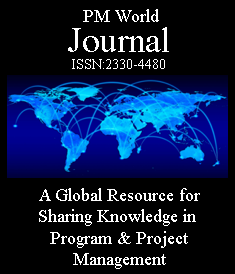Guidelines for External Evaluators
ADVISORY
By Dr. Kenneth Smith, PMP
Honolulu, Hawaii
& Manila, The Philippines
Programs and Projects are planned and funded to accomplish particular pre-specified objectives, whether undertaken by in-house personnel, or external contractors. Ideally, the Work Breakdown Structure (WBS), Critical Path Method (CPM) for ‘One-Off’ Projects, Just-in-Time/Line-of-Balance Methodology (JIT/LOB) for Repetitive-type Projects, and Earned Value Methodology (EVM) were utilized. During the execution phase, progress in terms of work accomplishment and related expenditures against the planned schedule & budget milestones — as well as any other Key Performance Indicators (KPIs) — should be systematically recorded by the implementers; then reported to higher level supervisors and management staff for status summarization, documentation and reporting to executives as well as other key stakeholders. Internally, the project management staff should also monitor activity and reports by ‘Ground Truthing’ – i.e. visits to job sites — to check with implementation personnel, local government organizations and target beneficiaries. Census, Systematic Random Sampling, Cluster Sampling, or Batch Quality Acceptance Sampling should be used, as best befits the nature of the Program/Project situation.
Ideally, during the planning stage, the Program/Project ‘business plan’ – complete with key performance indicators (KPIs) — was summarized in a Logical Framework and is readily available to the Evaluation Team, for reference. If not, the first task of the evaluation team will be to retroactively construct a logframe as best they can from available sources. Next, is to obtain ‘marching orders’ from the Evaluation Sponsor regarding his/her expectations, and obtain your team’s Scope of Work, your bounds, and key personnel to initiate and maintain contact throughout the study. Then locate and peruse the available Program/Project documentation.
Traditionally, it was assumed that all project implementation personnel had the best interests of the project in view; while, given the plethora of various professional Ethical Standards, organizational Codes of Conduct, as well as religious commandments to guide one’s personal predilections, we could accept at FACE VALUE what we were given, read and/or told, without question. For instance, while not a US Air Force Academy graduate, as a USAFA Liaison Officer, I adopted their Honor Code: “We will not lie, steal or cheat, nor tolerate among us anyone who does” as mine, and also applied it to my civilian professional project work.
Unfortunately, human nature being what it is, recent events have highlighted that some individuals involved in projects – rich in material things but poor in spirit – have reoriented their focus to their best interests rather than those of the projects and intended beneficiaries. As illustrated in the aphorism and graphic on the following page, graft & corruption at all levels – political, government agency, contractor & even in-house ‘watchdog’ personnel — in terms of rigged bidding with inflated costs – is manifest…
More…
To read entire article, click here
How to cite this work: Smith, K. F. (2025). Evaluating in the Program/Project Environment: Guidelines for External Evaluators, advisory, PM World Journal, Vol. XIV, Issue XI, November. Available online at https://pmworldlibrary.net/wp-content/uploads/2025/10/pmwj158-Nov2025-Smith-Guidelines-for-External-Evaluators.pdf
About the Author

Dr. Kenneth Smith
Honolulu, Hawaii
& Manila, The Philippines
![]()
Initially a US Civil Service Management Intern, then a management analyst & systems specialist with the US Defense Department, Ken subsequently had a career as a senior foreign service officer — management & evaluation specialist, project manager, and in-house facilitator/trainer — with the US Agency for International Development (USAID). Ken assisted host country governments in many countries to plan, monitor and evaluate projects in various technical sectors, working ‘hands-on’ with their officers as well as other USAID personnel, contractors and NGOs. Intermittently, he was also a team leader &/or team member to conduct project, program & and country-level portfolio analyses and evaluations.
Concurrently, Ken had an active dual career as Air Force ready-reservist in Asia (Japan, Korea, Vietnam, Indonesia, Philippines) as well as the Washington D.C. area; was Chairman of a Congressional Services Academy Advisory Board (SAAB); and had additional duties as an Air Force Academy Liaison Officer. He retired as a ‘bird’ colonel.
After retirement from USAID, Ken was a project management consultant for ADB, the World Bank, UNDP and USAID.
He earned his DPA (Doctor of Public Administration) from the George Mason University (GMU) in Virginia, his MS from Massachusetts Institute of Technology (MIT Systems Analysis Fellow, Center for Advanced Engineering Study), and BA & MA degrees in Government & International Relations from the University of Connecticut (UCONN). A long-time member of the Project Management Institute (PMI) and IPMA-USA, Ken is a Certified Project Management Professional (PMP®) and a member of the PMI®-Honolulu and Philippines Chapters.
Ken has two KENBOOKS: 1. Project Management PRAXIS which includes many innovative project management tools & techniques; and describes a “Toolkit” of related templates, and 2. MUSINGS on Project Management — a compilation of contemporary concerns in project planning, monitoring & evaluation, with some tools & techniques suggested for their solution. Either or both books are available from Amazon, and their related templates are available directly from him at kenfsmith@aol.com on proof of purchase.
To view other works by Ken Smith, visit his author showcase in the PM World Library at https://pmworldlibrary.net/authors/dr-kenneth-smith/









